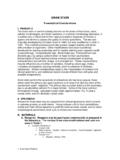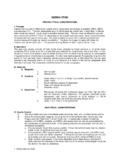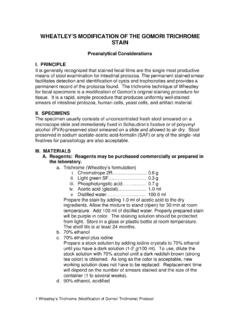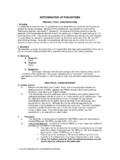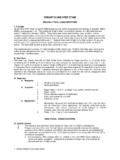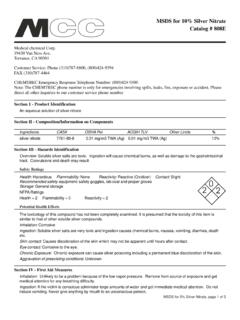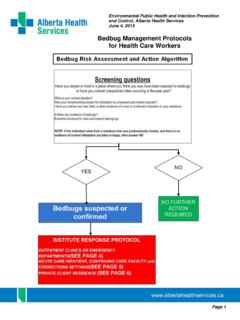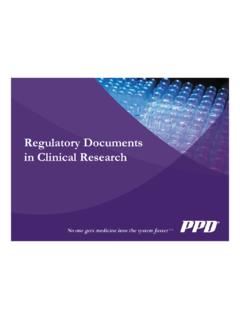Transcription of MODIFIED KINYOUN’S ACID-FAST STAIN (COLD)
1 1 MODIFIED kinyoun s ACID-FAST STAIN (cold) protocol MODIFIED kinyoun S ACID-FAST STAIN (COLD) Preanalytical Considerations I. PRINCIPLE Cryptosporidium and Isospora species have been recognized as causes of severe diarrhea in immunocompromised hosts, but they can also cause diarrhea in the immunocompetent host. Oocysts in clinical specimens may be difficult to detect without special staining. Cyclospora cayetanensis has also been reported to be acid fast . MODIFIED ACID-FAST stains are recommended for demonstrating these organisms. Unlike the Ziehl-Neelsen MODIFIED ACID-FAST STAIN , the MODIFIED kinyoun ACID-FAST STAIN does not require heating the reagents used for staining (1-4). II. SPECIMENS The specimen usually consists of concentrated sediment of fresh or formalin-preserved stool.
2 Other types of clinical specimens such as duodenal fluid, bile, or pulmonary (induced sputum, bronchial washings, biopsy specimens) may also be stained after centrifugation. III. MATERIALS A. Reagents: Reagents may be purchased commercially or prepared in the laboratory. a. Absolute methanol b. 50% ethanol i. Add 50 ml of absolute ethanol to 50 ml of distilled water. ii. Store at room temperature. Stable for 1 year. c. kinyoun carbol fuchsin d. 1% sulfuric acid i. Add 1 ml of concentrated sulfuric acid to 99 ml of distilled water. ii. Store at room temperature. Stable for 1 year. e. Methylene blue B. Supplies a. Glass slides (25 by 75 mm, 1 by 3 in.), frosted ends desirable b. Coverslips (22 by 22 mm; no. 1) c. Disposable glass or plastic pipettes d. Coplin jars or other suitable staining containers e.
3 Immersion oil C. Equipment: Optional materials, depending on specimen source of laboratory protocol a. Binocular microscope with 10X, 40X, and 100X objectives (or the approximate magnifications for low power, high dry power, and oil 2 MODIFIED kinyoun s ACID-FAST STAIN (cold) protocol immersion examination ). A 50X or 60X oil immersion objective is also very helpful in screening stained smears. b. Oculars should be 10X. Some workers prefer 5X; however, overall smaller magnification may make final organism identifications more difficult. c. Tabletop centrifuge d. Staining rack e. Fume hood to contain staining setup (optional) Analytical Considerations IV. QUALITY CONTROL A. A control slide of Cryptosporidium parvum from a 10% formalin-preserved specimen is included with each staining batch run.
4 If the cryptosporidia STAIN well, any Isospora belli will also take up the STAIN , as will C. cayetanensis (will be MODIFIED ACID-FAST variable). B. Cryptosporidia STAIN pink-red. Oocysts are 4 to 6 m in diameter, and four sporozoites may be visible internally. The background should STAIN uniformly blue. C. Check the specimen (macroscopically) for adherence to the slide. D. Cover all staining dishes to prevent evaporation of reagents E. Depending on the volume of slides stained, change staining solutions on an as-needed basis. F. The microscope should be calibrated, and the objectives and oculars used for the calibration procedure should be used for all measurements on the microscope. The calibration factors for all objectives should be posted on the microscope for easy access (multiplication factors can be pasted on the body of the microscope).
5 Although recalibration every 12 months may not be necessary, this will vary from laboratory to laboratory, depending on equipment care and use. Although there is not universal agreement, the microscope should probably be recalibrated once each year. This recommendation should be considered with heavy use or if the microscope has been bumped or moved multiple times. If the microscope does not receive heavy use, then recalibration is not recommended on a yearly basis. G. Known positive microscope slides, Kodachrome 2 x 2 projection slides, and photographs (reference books) should be available at the work station. H. Record all QC results, including a description of QC specimens tested; the laboratory should also have an action plan for ``out of control'' results. V.
6 PROCEDURE A. Wear gloves when performing this procedure 3 MODIFIED kinyoun s ACID-FAST STAIN (cold) protocol B. Slide preparation 1. Smear 1 to 2 drops of specimen on the slide, and allow it to air dry. Do not make the smears too thick (you should be able to see through the wet material before it dries). Prepare two smears. 2. Fix with absolute methanol for 1 min. 3. Flood slide with kinyoun s carbol fuchsin, and STAIN for 5 min. 4. Rinse slide briefly (3 to 5 s) with 50% ethanol. 5. Rinse thoroughly with water. 6. Decolorize with 1% sulfuric acid for 2 min or until no more color runs from the slide. 7. Rinse slide with water. Drain. 8. Counterstain with methylene blue or brilliant green for 1 min. 9. Rinse slide with water. Air dry. 10. Examine using low or high dry objectives.
7 To see internal morphology, use oil objective (100X). VI. RESULTS A. With this cold kinyoun ACID-FAST method, C. cayetanensis and the oocysts of Cryptosporidium sp. and Isospora sp. will STAIN pink to red to deep purple. Some of the four sporozoites may be visible in the Cryptosporidium oocysts. Some of the Isospora immature oocysts (entire oocyst) will STAIN , while in oocysts that are mature, the two sporocysts within the oocyst wall will usually STAIN pink to purple and there will be a clear area between the stained sporocysts and the oocyst wall. The background will STAIN blue or green, depending on the counterstain used. B. If Cyclospora oocysts are present (uncommon), they tend to be approximately 10 m, they resemble C. parvum but are larger, and they have no definite internal morphology; the ACID-FAST staining will tend to be more variable than that seen with Cryptosporidium or Isospora spp.
8 MODIFIED ACID-FAST stains STAIN the Cyclospora oocysts from light pink to deep red, some of which will contain granules or have a bubbly appearance, often being described as looking like wrinkled cellophane. Even with the 1% acid decolorizer, some oocysts of Cyclospora may appear clear or very pale. If the patient has a heavy infection with microsporidia (immunocompromised patient), small (1 to 2 m) spores may be seen but may not be recognized as anything other than bacteria or small yeast cells. Postanalytical Considerations VII. REPORTING RESULTS A. Report the organism and stage (do not use abbreviations) Example: Cryptosporidium parvum oocysts or Isospora belli oocysts or Cyclospora cayetanensis oocysts present 4 MODIFIED kinyoun s ACID-FAST STAIN (cold) protocol B.
9 Call the physician when these organisms are identified. VIII. PROCEDURE NOTES A. Routine stool examination stains are not recommended; however, the sedimentation concentration is acceptable (500 x g for 10 min) for the recovery and identification of Cryptosporidium and Cyclospora species. Routine concentration (formalin-ethyl acetate) can be used to recover Isospora oocysts, but routine permanent stains (trichrome, iron hematoxylin) are not reliable for this purpose. B. Polyvinyl alcohol-preserved specimens are not acceptable for staining with the MODIFIED ACID-FAST STAIN . However, specimens preserved in SAF are perfectly acceptable. C. Avoid the use of wet gauze filtration (an old, standardized method of filtering stool prior to centrifugation) with too many layers of gauze that may trap organisms and allow them to flow into the fluid to be concentrated.
10 It is recommended that no more than two layers of woven (not pressed) gauze be used; another option is to use the commercially available concentrators that use no gauze but instead use plastic or metal screens. D. Other organisms, such as ACID-FAST bacteria and some Nocardia spp., STAIN positive. E. It is very important that smears not be too thick. Thick smears may not adequately destain. F. Concentration of the specimen is essential for demonstrating organisms. The number of organisms seen in the specimens may vary from numerous to very few. G. Because of their mucoid consistency, some specimens require treatment with 10% KOH. Add 10 drops of 10% KOH to the sediment, and vortex until homogeneous. Rinse with 10% formalin, and centrifuge (500 x g for 10 min). Without decanting supernatant, take 1 drop of the sediment and smear it thinly on a slide.
